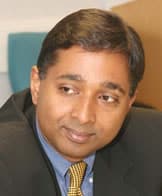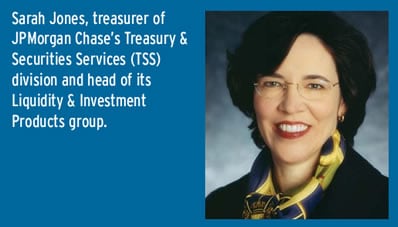Fast Forward
Global Finance brought together a group of experts to discuss how global solutions, changing regulations and non-bank providers are transforming treasury and cash management operations.
GLOBAL FINANCE:
Is it possible or desirable for a corporate to concentrate liquidity and cash management around a single global bank, or is a region-by-region approach preferred?
ELYSE WEINER,
managing director and global liquidity and investment product head, Citigroup: From a pure treasury perspective, you want to get the most utilization from your cash internally, and thats going to be facilitated by consolidating it within a single global bank. But there might be some issues to consider when looking at total transactional requirements, most notably concerns around risk management, credit extension and local business practices.
|
|
PHILLIP LINDOW,
head of global liquidity and investment management, ABN AMRO: The evolution in banking has made it much easier. And its not just the large corporates that are doing global cash concentration; its the middle market and smaller-size companies. For them it can be easier to effect centralization as they dont have the kind of large, complex receivable flows, which normally challenge a large multinational. Another driver to consolidating globally is Sarbanes-Oxley. Corporate treasurers might be uncomfortable with their knowledge of some of the lesser-known local banks, and they want to consolidate their funds with banks they know and trust. We also see big corporations starting to globally manage a single-dollar bookautomatically concentrating dollars that are coming in and being paid from a hub in, say, New York or Europe.
WEINER:
After the introduction of the euro, the focus was on taking advantage of that environmental change to implement euro pools in Europe. Once they saw what they could do with the euro, companies said, Why not global dollars? Now theyre moving on to multi-currency applications.
LINDOW:
Youre also seeing concentration on the global side, where you automate the drawdown out of your local banks into a central consolidation bank. And many entities consolidating regionally are now consolidating cross-currency regionally as well.
WEINER:
We divide core liquidity management into three streams. Global visibility is one of the primary requirements. Treasurers need to see their positions across all their banks, locations and operating subsidiaries. The second stream is analyticalthings like cash forecasting. The third phase is execution and optimizationbeing able to take an action based on the analytics. This includes application of liquidity management products and services such as pooling, automated cash concentration and investment services.
STEVE CANNING,
general manager UK, XRT: Its very rare that people consolidate with one bank on a global basis. Were seeing structures where theyre consolidating in a regional bankand they might even subdivide the regionbut it is rare to find one global bank. More and more people are also extending their forecast window far beyond the one week that people normally work to, to a month or even three-month forecast. And theyre getting more and more accurate, so people are having a better view of their positions.
SANJAY SRIVASTAVA,
chief operating officer, Aceva Technologies: For the right framework for the single-bank/multi-bank decision, look at best practices outside the financial world. We know the key to business competitiveness is multi-supplier relationships. Also, treasurers are starting to now think about working capitalreceivables and payables. This requires an open approach where you can work across multiple-bank relationships and ultimately utilize the best pieces, and technology has proven to make this work. Treasurers are using the right technology platform to apply key goals around liquidity management, risk management, operations efficiency and compliance management consistently across multiple relationships and reaping the benefits of the competitive environment.
WEINER:
Because of some of the payments standardization initiatives going on, such as SEPA, it is no longer the case that you can only get standardization within a single bank. Now you can get standardization across a region. Additionally, there are ongoing initiatives around standardization of communications protocols such as TWIST and RosettaNet.
SRIVASTAVA:
Technology is driving a lot of the standardization since you can work across multiple banks and tie it all together seamlessly using the right enterprise cash flow platforms. Equally, banking offerings are getting very commoditized; each relationship is starting to look like the others. That is where technology reinserts itself because banks are having to innovate continuously to differentiate their offerings relative to the others.
LINDOW:
Banks are becoming much more deeply embedded in their clients entire working capital management chain. Some of the changes in the industry are going to make this integration even easier going forward. Alignment of the physical and financial supply chains is made possible by integrating with both your banking partner and logistics provider. By doing this, you will be able to get that extended added value out of your bank; there is a natural drive toward consolidation or, at least, structures that consolidate cash.
SRIVASTAVA:
The key thing is its not only about cost; its about getting the best value for your business in a very competitive marketplace. Thats a combination of cost, products and services. The banks that can deliver that will get a disproportionate size of that opportunity.
WEINER: There still is a relationship aspect to consider. From a cost perspective, maybe one bank is a little better than another, but you have to take into account the relationship value-adds such as expertise and customized solutions.
CANNING:
We interface with over 200 banks around the world, and we give our clients the ability to chop and change between their banking relationships. A lot of people think thats a great bonus because that means that if they find a relationship is not beneficial to them, then its easy to switch from one bank to another. Thats one of the reasons why youre seeing banking relationships on a regional basis rather than on a global basis, because if you put all your eggs in one basket, its a major, major upheaval to move from one bank to another on a global basis. We have one or two that have gone on a near-global basis with a major bank, but theyve still maintained the local relationships in some of the lesser-known parts of the worldbut they pull everything out through one central bank. But most are doing it on a truly regional basis.
GF:
How have Sarbanes-Oxley and similar laws in other countries driven liquidity and other cash management practices?
LINDOW:
In some cases its pushing companies to consolidate into fewer banks because they just want to cut down the number of bank relationships they need to monitor. Treasurers are also becoming more directly involved in whats going on with day-to-day cash. They want to see a lot of transparency. So reconciliation issues are quickly escalated to top management; the amount of involvement from the top has gotten much deeper, much quicker.
SRIVASTAVA:
Today, most corporations can reactively report on non-compliance, on a look-back basis. But this isnt enough. The forward thinkers are already moving on to proactively ensuring compliancethrough real-time monitoring of transactions and resolving issues as they arise. The largest impact of this is that it forces companies to think about their transaction processes and monitor how the money flows within and outside the company. As we move to more of a proactive monitoring world, companies will use technology that enables them to monitor transactions in real-time and automate those control points.
|
|
WEINER:
One of the basic concerns we see with respect to control is account opening and closing. This is so complex for a company thats operating in multiple countries. The treasurer needs to know who has signing authority on the account, who opened it, how many accounts they really have. There are still large and sophisticated companies out there that have no idea how many accounts they have or whats in them or whos got the signing authority. Treasury functions are starting to get involved in all of these nitty-gritty details in response to the increasing focus on control.
GF:
What impact will the enforcement of the Single European Payments Area [SEPA] have on corporates, banks and their software solution partners?
CANNING:
Theyre regionalizing based upon currencies. If youve got one local payment area where, in theory, it should be the same cost to pay wherever you pay it from, theyre now going to centralize the treasury operations. It cuts down administrative costs considerably by just having one single payment location.
LINDOW:
There is a lot of stress on companies to update their technologies to handle having all their payments coming into a single account. As companies reduce the number of accounts they have, theres been significant demand on the software vendors to make reconciliation work more accurately. This may slow down the adoption of SEPA into a single account. From the liquidity and cash management perspective, SEPA brings standardization within Europe of cut-off times, payment timing, value-datingand cost. That will make operating a consolidated cash pool much more efficient.
SRIVASTAVA:
Most treasurers want to see this happen as soon as possible because they are under pressure to cut the total cost of financial operations from the current levels around 5% of revenues to 3% or 2%. Utilizing SEPA, theyll be able to set up shared services centers that drive the cost of payables and receivables processing further down.
WEINER:
Yes, SEPA is going to facilitate the consolidation of payments processing by corporations. On top of SEPA, you have more countries coming into the EU and eventually joining the euro, so youll see even further consolidation. The impact on banks is likely to be the most profound.
GF:
Is it possible some non-bank providers may disintermediate banks from the payment process? What are some of the top untapped opportunities to apply technology in the cash management area?
WEINER,
The question keeps coming up: What is the role of technology companies in the payments process? The technology company may provide the interface, but the bank still extends credit and maintains the risk.
LINDOW:
I see technology as providing ways to streamline the banking process. Banks spend a lot of money on their in-house systems. The role of the technology firms could become more generic, filling the gaps.
SRIVASTAVA:
The key question is whether it is the bank or the technology company that will provide innovative technology thats of most value to the companies they work with. One of the biggest challenges for treasurers working with banks is that typically about 8% to 10% of the data coming never reconciles with the ERP system; people have to resolve it manually. This issue has been around for years now. Technology can actually reconcile those transactions such that incoming information is 100% reconciled to the ERP. Whoever provides that solution will ultimately add a lot of value to the end-user.
WEINER:
Look at something like CLSwhich is basically a clearinghouse for FX settlement. Ultimately the liquidity within the clearing systems has to be managed by the banks. Only a bank can maintain the risk, credit and liquidity controls to ensure payment finality.
CANNING:
One of the big problems is that reconciliation tools are only as good as the information you get from both parties. If the information were getting from the bank or from the ERP system is not good enough, we cant reconcile it. The standardization needs to be there. Then youll get near 100% reconciliation.
GF:
How should a CFO define best practices considering liquidity, risk management, compliance and operations?
SRIVASTAVA:
That links to the idea of treasurers establishing a consistent set of policies across enterprise cash. Treasurers dont want to get caught up in the daily reviews of every single different account or different country positions, but they want to be able to make standardized decisions at one time and have some sort of a platform that actually implements that consistently around the world. You want to be able to see the forest for the trees. They want to be able to know what is going on at any level in their organization and actually act on that information. Technology platforms enable this today.
WEINER:
Best practice is somewhat misleading because what works for one company might not be the best solution for another. When structuring a liquidity solution, one has to consider the unique and particular tax, organizational and financial goals of the enterprise.
LINDOW:
Control is probably the key word right now. The underlying themes are consistency and visibility, and you should benchmark your practices on that. You can also benchmark your company by industry standards of days sales outstanding.
CANNING:
Treasurers are going out asking third parties to help them establish best practice within their treasury operations. They are accepting that they might not already be doing everything as well as they could.
LINDOW:
Theyre also asking their consultants or their auditors about issues and concerns other clients have had, and to point out to them pitfalls or challenges.
WEINER:
The banks are taking on more and more of that responsibility, but we also walk a very fine line because we cant be perceived as offering tax or accounting advice. We advise our clients to consult with their internal tax, legal and accounting advisers prior to reengineering their treasury operations or practices.
GF:
How are cash investment and liquidity management practices changing?
CANNING:
In the past six to nine months, more and more of our corporates are talking about a different approach. SOX says you have to ensure youre getting the best return on investments, so companies are beginning to use portals where they can do all their FX, all their money market investments from one place, rather than ringing round to individual banks. Things are changing in that market a lot and, I believe, will continue to do so.
LINDOW:
Software is helping with forecasting and helping cash managers identify their core cash. Now that treasuries have a better handle on forecasting and their core cash, they are often doing cleverer things with them than just time depositslike investing in higher-yielding funds.
WEINER:
We find that corporations are not choosing to invest working capital in exotic instruments because safety and security are ranked number one above yieldalways. Better forecasting is paying off. Corporations that forecast effectively earn on average an additional 30 basis points on their investment portfolios.
LINDOW:
The reporting is another factor. If Im a treasurer investing to a consolidated portfolio, I also get consolidated reporting out of that.
SRIVASTAVA:
There is a lot of interest now in the money thats just stuck in the financial supply chain: How do you pull money out of unnecessarily bloated working capital and put it to more productive use? The financial supply chain is still stuck in month-long cycles, and thats costing companies a lot of money thats not in either operations or in invested capital. And it isnt getting any better on its own. Treasurers can apply the same skills to the working capital area and deliver significant incremental results to the bottom line.
CANNING:
The financial value chain has extended from just the pure treasury to the payments on one side and the collections on the other. You can have a much better cash management situation if you can get better control over your payments and your collections; youve got a complete chain.
WEINER:
A lot of corporates today have record levels of cash on the balance sheet, so now they want to know, What is the optimal level of cash one should hold on the balance sheet, and is it being effectively deployed within the organization? As you become more efficient, you start to impact the dynamics of the balance sheet. Once you start to free up this working capital, you then have to decide what do to with it to maximize return.
GF:
What is your vision of the future of this business?
SRIVASTAVA:
The top 1,000 companies in the US, western Europe and Japan have $2.5 trillion on the balance sheet for accounts receivable. Thats a tremendous amount of capital that is stuck in the financial supply chain. In the next 10 years that cash is going to move around, and as it moves from one end of the supply chain to the other, it will transform a lot of components of the industry around it. For the treasurer its a large opportunity. By redistributing the capital into more efficient areas, it brings down the weighted average cost of capital for the corporation.
WEINER:
I see a growing integration of the core components of the cash conversion cycle across the financial supply chain. This integration will serve to release working capital to be redeployed into value creation such as investments in new markets and new products.
LINDOW:
The big trend I see is that small and medium enterprises will be adopting best practices from the very biggest corporations. They will adopt processes that have been streamlined, tested, and proven efficient by these large corporations. These automation and consolidation structures being adopted by medium-size and smaller firms can have a tremendous impact, and they can get projects put in very quickly, very efficiently.
WEINER:
The banks are helping in this regard. They are offering light versions of some of their more advanced electronic banking platforms specifically for SMEs to give them some of the visibility and control they might otherwise not have.
CANNING:
The actual cost of treasury management systems has come down dramatically, and there is a drive to make deployment much easier. Theres a big drive to use DotNet technology to deploy systems. Were seeing huge demand from companiesonce they centralize all their cash management and their treasury functionalitythat want to give their subsidiaries the ability to see what the positions are and to accurately forecast their requirements.
|
INTERVIEW: SARAH JONES, JPMORGAN CHASE |
|
|
The banks that can integrate the cash concentration and investment equationand also provide the reporting that ties it all togetherwill be the ones that companies look to as their global requirements evolve. Flexibility is key: Each company has different needs, and each should seek a provider that can adapt to the liquidity requirements of the company, rather than expecting the company to adapt to the banks model. Banks that can provide a choice of concentration methods and concentration centers and a diverse range of investment options will enable their clients to make the most of global cash.
The trends are leading to a time of more standardization in treasury operations and greater transparency in reporting, giving CFOs and treasurers more opportunities than ever to create sustainable value for their companies. |
Moderated by Joseph Giarraputo








